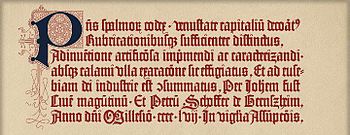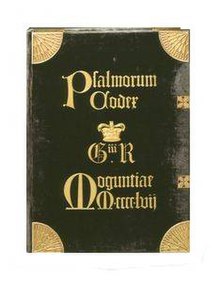Mainz Psalter
The Mainz Psalter was printed on parchment in 1457 in the office of Peter Schöffer and Johannes Fust ; the incunable is considered to be one of the outstanding pieces of early book printing .
description
The Mainz Psalter , a collection of psalms in Latin for liturgical use, was published in two editions with 143 and 175 sheets respectively. Both were printed on parchment and in one column, that is, with one column per page. Different types of material were used for printing , a large and a small psaltery type, based on a missal textura of liturgical manuscripts, and uncials , rounded letters, in several sizes.
The specialty of the Mainz Psalter was the multicolored print in black, red and blue. For this purpose, the elements to be printed in color, mostly initials and ornaments, were removed individually from the text set, colored separately and then reintegrated into the now black printing block. This sentence was then printed in one step. Schöffer invented a metal stick for the initials of the psaltery print, which in Gutenberg's prints were made by hand as in the medieval manuscripts , which allowed him to print them in two colors, for example in his edition of Valerius Maximus from 1471 According to the information in the colophon, the printing of the psalter was finished on August 14, 1457. This makes it the first dated incunable in written history.

The impressive type design led to the assumption that the elaboration, which must have been time-consuming and costly, was started while working with Johannes Gutenberg . Fust and Schöffer completed the work and printed the psaltery in their office. A second psalter, the so-called Psalterium Benedictinum , appeared in Mainz in 1459, also printed on parchment, now in a somewhat smaller Gothic type. Schöffer continued to use the Psalter type stock and the special printing blocks for the decorative elements. B. for the Canon Missae , 1458, and a second edition of the Psalterium Benedictinum from 1490. The small type of Psalter was used in Basel after 1473 to print the Missale speciale (formerly Constantiense) .
Copies

There are 13 originals known in various states. Undamaged copies can be found in the Darmstadt University and State Library , the Dresden State, State and University Library (Perg.), The Rylands Library Manchester , the Munich State Library , the Scheide Library Princeton (2 copies) and the Vienna National Library (Perg. ). Keep damaged copies: Angers (missing sheets), Staatsbibliothek Berlin (perg., 1 sheet missing), Goodhart Library Bryn Mawr, PY (damaged), British Library London (missing sheet), Bibliothèque nationale Paris (missing sheet), Royal Library Windsor (missing sheet).
Fragments can be found at almost 20 other locations. The two copies pergamentierten Dresden and Vienna are the most important, the latter in 2011 as a World Documentary Heritage of UNESCO entered.
A facsimile was published in Dietikon / Zurich in 1968/69. Digitization started the ULB Darmstadt and ANL Vienna (digitized).
literature
- Fritz Funke : Book customer. An overview of the history of books and writing . Munich-Pullach 1969, p. 82ff.
- Hellmuth Lehmann-Haupt: Peter Schöffer from Gernsheim and Mainz . Reichert Verlag, Wiesbaden 2002, p. 31 ff.
- City of Mainz (Ed.): Gutenberg - Aventur and Art. From secret company to the first media revolution. Mainz 2000.
- Otto Mazal : The Mainz Psalter of 1457. Commentary on the facsimile print. Verlag Bibliophile Drucke von Josef Stocker, Dietikon-Zürich 1969. (With a foreword by Prof. Dr. Aloys Ruppel , Mainz)
Web links
- ÖNB digitized
- Entry in the Incunabula Short Title Catalog
- Mainz Psalter in the general catalog of incunabulae (GW number M36179)
Remarks
- ↑ Lehmann-Haupt p. 36f.
- ↑ Lehmann-Haupt p. 34ff.
- ↑ Lehmann-Haupt p. 37
- ↑ Lehmann-Haupt p. 38
- ↑ a b Weblink complete catalog of the Wiegendrucke

